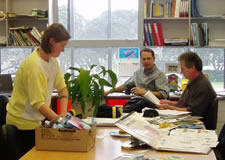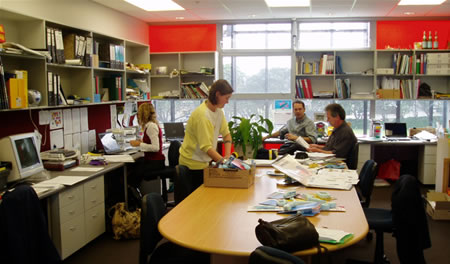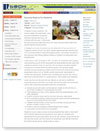Success Rubrics for Students

Class: Years 9-13
Teacher: Lesley Pearce
School: Takapuna Grammar School
Category: Teaching Strategy
It happens in every classroom – the teacher explains the requirements, asks if everyone understands, accepts the affirmative murmurs and nods, and continues with the lesson. Further down the track it becomes evident that some, if not most, of the class didn't really know exactly what they should be doing.
A strategy to overcome this problem saw the introduction of 'success rubrics' at Takapuna Grammar School. The rubrics showed students precisely what they had to do to provide evidence of their technological practice, encouraged 'ownership' of their work and made offering different methods of evidence for assessment more straightforward.
Lesley Pearce, HOD Technology in 2007, had been concerned that senior students were presenting work for NCEA assessment that demonstrated that they hadn't fully understood what they had to do, and that a lack of evidence resulted in students missing out on Achieved, Merit or Excellence grades. She says that despite spending class time explaining in detail what the Achievement standard assessment requirements meant, such as "identify possible needs and/or opportunities" or "explain their implications", students were completing work and only then saying "I didn't know what that meant" or "I missed that out, I didn't realise it was important".
Lesley says that over the years she had reflected on how best to scaffold her students' learning to allow them a successful outcome that clearly met assessment criteria. After researching assessment styles she concluded that:
- Students should self-monitor, but that teachers needed to work with them to assure their competence in assessing their own work.
- There needed to be clear, concise marking criteria that students/parents could really understand
- Students should be aware right from the start what every detail entails
- Rich conversations between student and teacher require pertinent questioning by teacher to ensure students think more deeply
- Feedback should be timely so that it advances learning, not just given when students complete a section of work
- Evidence could be presented as written/oral/observed or images
- Assessment must be efficient and manageable
Students in one of Lesley's classes had liked using what they called a 'cheat sheet' which explicitly stated what was expected for each aspect of a Standard and allowed them to tick each task off their list one-by-one. However, Lesley felt that this still wasn't the answer, did more research on assessment, and, with Bill Collis from Mt Roskill Grammar School, started looking at rubrics.
Lesley investigated why some senior secondary students had difficulty in understanding the language of Achievement standards – key factors/implications/needs and opportunities, etc – and how rubrics are used internationally. She decided that to be effective for assessment purposes a rubric needs to use specific language that links with student thinking, so that students understand exactly what a teacher means, and that motivates them. Lesley says that she went back to the language used successfully by primary school teachers, which is positive, explains exactly what is required in simple terms, and gives students a 'pat on the back' – an "I can do this".
To work out the fine details of Achievement Standard requirements, Lesley looked at all the Achievement Standards assessment specifications, explanatory papers, examiners' reports and moderators' reports. She rephrased them in simple language and trialled these rubrics with Steve Pearce's Year 11 Technology class of 24 students, selected because they were all boys (boys weren't achieving as well as girls in written assessments) and some of whom, she says, didn't feel part of their own learning process.
The class worked on a new Electronics unit and was assessed for Achievement Standards 1.1, 1.2 and 1.6. The new rubrics for each standard clearly stated what students had to do to attain Achieved, Merit or Excellence. It was important that the statements reflected the learning in the unit being undertaken at the time, which in this case related to the issue of security in the context of electronics. The broad statements from the original standards, for example 1.2, were made into sentences that students could understand and which gave them a feeling of accomplishment as they ticked off each 'I can..." statement
The rubrics also showed students various methods of providing their evidence; for example, in AS 1.1 students could show their planning through a diagram instead of writing out a Gantt chart or key milestones. As they completed each section students noted the workbook page which showed evidence of what they had done. Lesley notes that teachers still needed to check what students ticked, and that if the evidence didn't support a student's assessment of his work then he would need to justify his conclusion during a teacher/student conference.
The new rubrics proved successful in clarifying student understanding and the boys took more 'ownership' of their work than previously. Lesley attributes this improved engagement to the friendly language of the rubrics which encourages students to think they can achieve. Moderator feedback confirmed that the rubrics helped students understand how they had to provide evidence of their achievement.
In 2008 the 'success rubrics', as they came to be called, were introduced to all Technology and Graphics classes. Teachers have found them helpful and some have adapted them as a weekly list, to ensure students keep up with class progress. The rubrics are also on classroom walls as posters, so that teachers can refer to them when querying class progress on a project. Lesley says that she gave her classes the issue and the success rubrics but not the Achievement Standard criteria, which they could look up if they really wanted to.
Some assessment strategies have been modified – for example Steve has replaced "I can..." statements with "I have evidence of..." to help students understand exactly what they are providing for assessment. Teacher/student conferences entail the teacher taking notes on students' explanation of their work, a time consuming process, so sometimes students are paired instead – one will ask questions, such as "Tell me why these key factors are relevant", and write down the responses. Lesley notes that a teacher needs to know the students and pick the right partners for this exercise.
Every Technology/Graphics teacher has a digital camera for recording student work and all senior projects are completed by the end of term 3, to allow three weeks in term 4 for students to provide evidence of their learning.
Lesley did a presentation on success rubrics to the whole school staff and consequently some other departments have decided to incorporate these into their programmes.
Updated Rubrics downloads
1.1 'I Have' (.doc, 45kb) | 1.2 'I Have' (.doc, 43kb) | 1.6 'I Have' table (.doc, 35kb)

Technology department workroom

